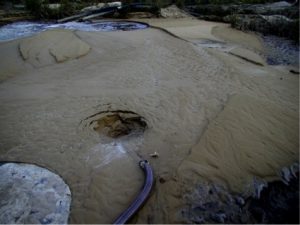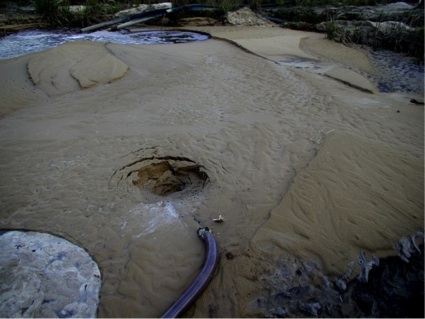Pneumatic conveying units have the capability of recovering material by two modes- the first being “pure vacuum” while the second is “air conveying”.
As a general rule pure vacuum would be used for removing sludge from beneath liquid- or for rapid liquid or slurry loading within close proximity to the machine. In this mode, the vacuum tube is totally submersed in the liquid and only material (no air) transports through the line. The maximum vertical suction lift from the machine to the liquid surface cannot exceed 9.2 meters or 30 feet at sea level assuming water is the liquid. Horizontal suction distances would be greater. For materials of a higher density than water, these figures must be reduced accordingly. This mode is a conventional pumping technique with the material being displaced by negative pressure.
However pneumatic conveyance SX Solids machines can transcend conventional pumping techniques by pneumatically conveying materials.
Pneumatic conveying is a method of handling materials by utilizing high velocity airflow with a pipeline. This requires sufficient air velocity to pass the material being picked up to capture it and convey it through the vacuum tube to the machine. The air velocity is kept up by not fully submersing the nozzle or by allowing air to the pick-up point via a snorkel tube attached to the nozzle.
The advantages of this technique are:
- Vertical suction lifts up to 25 meters+ or 80 feet + can be achieved
- Materials can be liquid, dry or damp
- Particle sizes of up to 80% of the suction hose diameter can be conveyed
- Horizontal suction distances in excess of 60 meters can be achieved
- Fibrous, waxy and heavy sludge can be handled
- Powders and solids can be handled as well as wet materials
 There are also applications where a vacuum fluidizing tube should be used which combines the benefits of pure vacuum and pneumatic conveyance when removal of material from beneath liquids is required where the distance exceeds the limitations of pure vacuum.
There are also applications where a vacuum fluidizing tube should be used which combines the benefits of pure vacuum and pneumatic conveyance when removal of material from beneath liquids is required where the distance exceeds the limitations of pure vacuum.
All pneumatic conveyance SX Solids units utilize high airflow and vacuum (up to 25’’ HG+) to ensure high performance.
This SX Solids range of equipment is designed to enable the user to either convey recovered material into a collection vessel where the contents are discharged under gravity or alternatively the recovered material can be discharged under gravity or alternatively the recovered material can be discharged under pressure, through a pipeline.
Two modes of positive pressure discharge are used in pneumatic conveyance SX Solids machines- dense phase and lean phase pneumatic conveying. The later can achieve vertical heads in excess of 35 meters (115ft) and horizontal discharge distances of over 1000 meters (3200ft).
The absence of any electrical supply in these SX Solids machines makes them useful in restricted or potentially hazardous areas such as underground mines or in oilfield/platform service..
Regarding flow rates, the distance to some extent is irrelevant (At least up to the 500 foot mark), the controlling issue is the timing. A venturi requires its air to constantly expand once it passes the recovery angle of the nozzle, any back pressure and the vacuum drops significantly. Keep in mind how vacuum works and increases, for example raising the vacuum from 20”hg to 23”hg are far easier than say 24”hg to 25”hg, meaning slight drops are actually more significant at the top end of the performance. Very similar to decibel readings: 135db will make you nauseous with a possible nose bleed but 125db is rock n roll such as AC/DC. On the discharge side please envisage the force delivered when a car tyre blows out at say 35psi, a pneumatic conveyance SX Solids unit utilises the same principal but places a slug of slurry in front of the explosive energy and then focuses that down a pipe. Operating on Bernoulli’s 4th principal “for every action there is an equal and opposite reaction”. Thus our slug enters the clear line, pigs the line clean as it travels down the pipe at about 50-60 km/h, picks up the expanded air from the previous cycle and turns it into a ram for the material ahead, until it exits. Simple stuff, as long as you’re aware of and recognise the various “art” aspects of this basically brute force and ignorance method. With regards to pump curves this would be nearly impossible to assemble given the variations in both the materials being transferred and the energy medium employed, i.e. air. As a short indication of this your curve would need to take into account the following including any variations, the material’s SG, it’s viscosity, the compressed air volume and pressure available, the altitude at which the equipment is working, length of suction and discharge hose, pipe run (bends, rises etc.) and type of hose/pipe employed along with operator skill if the task requires one. Also to consider: Is the material sticky or gritty?, What size solids are in the mix?, Does this change?, Does the operator keep the nozzle in the material?, Is the compressor delivering 400cfm at 102 psi or 380cfm at 95 psi? Keeping in mind that you are pneumatically conveying more than “pumping” so the curve becomes impossible to lock down.
Can such equipment be turned down from 600cfm air consumption down to 400 or lower cfm air consumption? Yes, these types of units can be fitted with 750, 600, 400, 270 or even 180cfm Jet Packs if required but obviously this impacts on the performance of the unit although as indicated above the impact would depend on the application and duty required. All of the Jet Packs are designed to deliver around 25″Hg of vacuum so that would be maintained no matter what size vessel you attach it to, the second aspect to take into consideration is the speed at which the air is evacuated from the vessel as this obviously relates directly to how fast the air wishes to enter the vessel and the pick-up and convey velocity within your suction hose. The Jet Packs are all designed to complement the vessel they are attached to but as indicated, they can all be mixed and matched but it’s generally determined by the material you need to recover/transfer, the overall volume and how fast you need this to be done. These pneumatic conveyance usually come standard with a 600cfm Jet Pack which operates at its peak at around 85-100psi, both these units can be fitted with 400cfm Jet Packs if required and although these generate the same 25″Hg of vacuum, the rate at which the air is evacuated from the tank is reduced slightly and therefore the rate at which the air enters the vacuum line is obviously also reduced. (Keeping in mind that you are working with both Vacuum and Air Flow) In short, the vast majority of the job’s you’ll come across will be handled by the 400cfm unit easily but on occasion when pumping the real “ugly” stuff you may need that extra grunt. The airflow aspect comes into play when there is less liquid around or the material is particularly waxy or heavy. What are the advantages / disadvantages of a larger unit vs. a smaller one? With regards to the difference between a large or small unit it’s just vessel size in litres and as this is a batch system, i.e. it sucks in a load and then discharges that every say 10 or 12 seconds and it’s doing this 24/7 then the 1, 2 or 3 seconds difference for each cycle add up to volume at the end of the day……….and how much that is “exactly” relates directly to the SG and other variables of material being handled. These types of units are certainly not ground breaking technology, what they are is a reliable means of recovering a vast array of aggressive materials via vacuum and transferring this over a distance of generally 1000 metres or less for long periods of time with little or no wear and they can do this for years with just general mechanical maintenance and I’ve yet to come across anything that does it as well.
For more information, please contact:
Glenn van der Werff
Business Development Manager – Canada
Dir. Développement Affaires – Canada
Tyco Pumping Systems
579 boul. Lionel Boulet
Varennes, QC J3X 1P7
Phone: 450-652-3921
Mobile: 514-235-9941
Fax: 450-652-2118





Comments